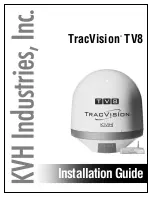
4. Fitting the antenna
Remove protective backing from underside of antenna, feed coaxial cables through panel. Position the antenna over the hole ensuring correct orientation
and stick to panel by applying firm downward pressure. It may be advisable to apply a very small amount of neutral cure silicone sealant around the base of
the mounting boot to overcome friction and allow the boot to fully compress against the mounting panel.
Waiver: This document represents information compiled to the best of our present knowledge. It is not intended to as a representation or warranty of fitness of the products described for any
particular purpose. This document details guidelines for general information purposes only. Always seek specialist advice when planning installations and ensure that antennas are always
installed by a properly qualified installer in compliance with local laws and regulations.
Head Office
61 Frogmore, Wandsworth, London, SW18 1HF, UK
Waste electrical products should not be disposed of with household waste. All electronic products with the WEEE logo must be collected and
sent to approved operators for safe disposal or recycling. Please recycle where facilities exist. Many electrical/electronic equipment retailers
facilitate “Distributor Take-Back scheme”for household WEEE. Check with your Local Authority or electronic retailers for designated collection
facilities where WEEE can be disposed of for free.
Directive 2011/65/EU (RoHS 2)
RoHS 2 compliance is declared per Directive 2011/65/EU and its subsequent amendments with exemption 6.c applied.
REACH (Registration, Evaluation, Authorisation and Restriction of Chemicals, EC 1907/2006)
This product contains Lead (CAS No. 7439-92-1) which is classified as an SVHC (Substance of Very High Concern) as being toxic to
reproduction under Article 57c. of REACH. Do not chew parts or put them in mouth, keep away from unsupervised children. Dispose of parts
as WEEE waste do not send to landfill.
This declaration is issued under the sole responsibility of the manufacturer
The object of the declaration described above is in conformity with the relevant Union Harmonization Legislation below:
Directive 2014/53/EU
Radio Equipment Directive (RED)
Harmonised Standards and References:
EN 301 489-1 (V2.1.1): “Electromagnetic compatibility and Radio spectrum Matters (ERM); Electro Magnetic Compatibility (EMC) standard for
radio equipment and services; Part 1: Common technical requirements”.
Referencing EN 61000-4-2:2009 – Electrostatic Discharge Immunity and EN 61000-4-3:2006 +A1:2008 +A2:2010 – Radiated RF Immunity
EN 300 440-1 V1.6.1 (2010-08) – Electromagnetic compatibility and radio spectrum matters (ERM); short range devices; radio equipment to
be used in the 1GHz to 40GHz frequency range; Part 1: Technical characteristics and Test methods in accordance with EN 300 440-2 V1.4.1
(2010-8) - Electromagnetic compatibility and radio spectrum matters (ERM); short range devices; radio equipment to be used in the 1GHz to
40GHz frequency range
Low Voltage Directive: Directive 2014/35/EU (Electrical Equipment designed for use within certain voltage limits) of 26th February 2014.
EN62368-1: 2014 Audio/video, information and communication technology equipment. Safety requirements
CAUTION - To comply with FCC RF Exposure requirements in section 1.1310 of the FCC Rules, antennas used with this device must be
installed to provide a separation distance of at least 20 cm from all persons to satisfy RF exposure compliance.
DO NOT
• operate the transmitter when someone is within 20 cm of the antenna.
• operate the equipment in an explosive atmosphere.
When routing the cables take care to avoid running them adjacent to any existing vehicle wiring or fouling any moving vehicle components.
The cables must not be routed in front of any airbag device.
5. Routing and terminating coaxial cable(s)
If heat shrink tubes are to be used, slide onto antenna cable tails prior to connecting extension cables – it is recommended that these are heat shrunk only
after tests have been satisfactorily completed. Connect extension coaxial cables to antenna and route to equipment. Fit correct coaxial connector or adapter
to cables as required.
6. Commission and test
Check GPS/GNSS cable (where applicable):
● Check the GPS/GNSS cable with DC to measure high resistance.
● Connect the GPS/GNSS cable to the GPS receiver and check for satellite acquisition.
Check comms cable(s)
● Earth continuity: connector body to vehicle ground should measure <0.2Ω;
● Connector body to centre pin should measure open circuit.
● Carry out VSWR check, should measure as specified in the antenna data sheet.
● Connect GSM / Cellular, LTE & WLAN cables or stow unused pigtails.
7. Notices
Caution
– A slotted/split nut is provided in order to simplify fitting it over the coaxial cables. When fitting the nut, it is important to ensure that the cables are
held centrally whilst the nut is correctly started on the threads. The nut should fit freely by hand and only require a final tighten by spanner.
Assemble the nut and washer from underside and tighten to recommended torque of 5Nm. Remove blanking cap and screw comms antenna whip securely
to mounting stud (if applicable).




















